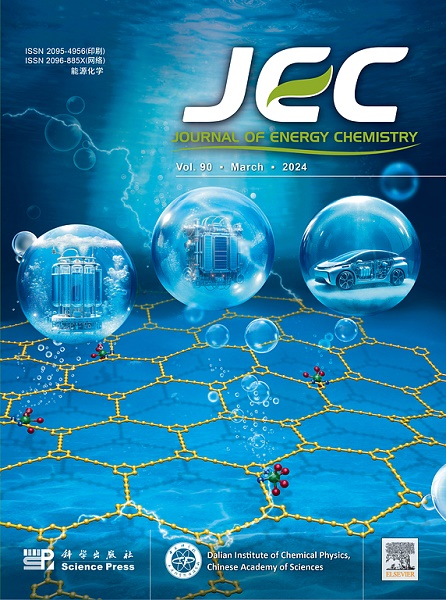Double-protective strategy enabling high-efficiency production of levulinic acid from high-loading cellulose
IF 13.1
1区 化学
Q1 Energy
引用次数: 0
Abstract
Valorization of renewable cellulose into initial platform chemicals (IPCs) generally suffers from low process efficiency owing to difficult depolymerization of recalcitrant cellulose and troublesome repolymerization of high-reactive intermediates to undesired humins. Herein, we report a double-protective strategy for cellulose depolymerization and orientated conversion to levulinic acid (LA), one of the important IPCs, by in-situ adding protective formaldehyde (HCHO). This approach initiates from the (hemi)acetalation of hydroxyl groups in cellulose with HCHO, causing controllable depolymerization to (hemi)acetalized glucose with increased rate kinetically and a new mechanism of its catalytic conversion to LA via (hemi)acetal-driven direct C1–C2 cleavage. As such, the cellulose-to-LA conversion is protectively proceeded with the repolymerization of reactive intermediates prevented remarkably, leading to an excellent LA yield of 87.3 mol% from high-loading microcrystalline cellulose (15.0 wt% in aqueous phase) in a biphasic solvent containing 2-methyltetrahydrofuran and water. The process efficiency, expressed as space-time yield, is improved by 3.6 fold when compared with a non-protective approach. This work highlights an advance in maximizing the utilization of biomass-derived carbons for high-efficiency production of important IPCs directly from cellulose for future biorefinery.

双保护策略使高负荷纤维素高效生产乙酰丙酸
可再生纤维素转化为初始平台化学品(IPCs)的过程效率较低,这主要是由于难降解纤维素的解聚和高活性中间体重新聚合到不需要的人类物质的麻烦。本文报道了通过原位添加保护性甲醛(HCHO)对纤维素解聚和定向转化为乙酰丙酸(LA)的双重保护策略。该方法从纤维素中羟基与HCHO的(半)乙酰化反应开始,在动力学上引起可控解聚以加快(半)乙酰化葡萄糖的速率,并通过(半)乙酰化驱动的直接C1-C2裂解催化转化为LA的新机制。因此,在含有2-甲基四氢呋喃和水的双相溶剂中,高负荷微晶纤维素(水相中为15.0 wt%)的LA产率达到87.3 mol%。以空时产率表示的工艺效率,与非保护方法相比提高了3.6倍。这项工作强调了最大限度地利用生物质衍生碳,直接从纤维素中高效生产重要的ipc,用于未来的生物炼制。
本文章由计算机程序翻译,如有差异,请以英文原文为准。
求助全文
约1分钟内获得全文
求助全文
来源期刊

Journal of Energy Chemistry
CHEMISTRY, APPLIED-CHEMISTRY, PHYSICAL
CiteScore
19.10
自引率
8.40%
发文量
3631
审稿时长
15 days
期刊介绍:
The Journal of Energy Chemistry, the official publication of Science Press and the Dalian Institute of Chemical Physics, Chinese Academy of Sciences, serves as a platform for reporting creative research and innovative applications in energy chemistry. It mainly reports on creative researches and innovative applications of chemical conversions of fossil energy, carbon dioxide, electrochemical energy and hydrogen energy, as well as the conversions of biomass and solar energy related with chemical issues to promote academic exchanges in the field of energy chemistry and to accelerate the exploration, research and development of energy science and technologies.
This journal focuses on original research papers covering various topics within energy chemistry worldwide, including:
Optimized utilization of fossil energy
Hydrogen energy
Conversion and storage of electrochemical energy
Capture, storage, and chemical conversion of carbon dioxide
Materials and nanotechnologies for energy conversion and storage
Chemistry in biomass conversion
Chemistry in the utilization of solar energy
 求助内容:
求助内容: 应助结果提醒方式:
应助结果提醒方式:


